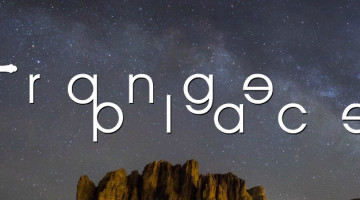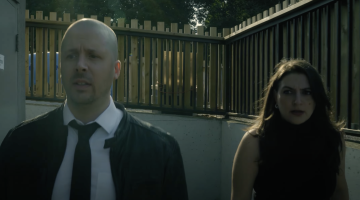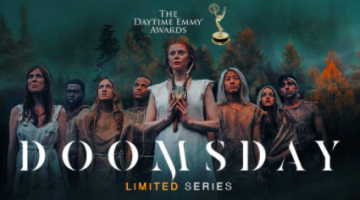In a world where new video content is produced at a dizzying pace, creators of web series have always fought to make their shows unique. With the priorities of their audiences and pocketbooks in mind, filmmakers also need to find platforms that use advanced technology to build viewers and monetize content.
The newest of those platforms is Seeka TV, co-founded by VP of Programming George Reese, CEO David Bagley, and former Dell chief technology officer Donald Ferguson. Seeka TV made its official launch at this past March’s SXSW (South By Southwest) festival. Viewers can sign up for a free user account on its official web site (see link below), which is currently in Beta testing.
Since variety is truly the spice of life, there’s plenty of it in abundance on Seeka TV’s main portal. As a content curator, Seeka TV includes hilarious comedies (47 Secrets To A Younger You, The Pantsless Detective, 20 Seconds To Live and Working On It), dramas (Blue Collar Hustle, Bennington Gothique) and sci-fi (The New Adventures of Brobot Johnson, Soldiers of Earth).

Seeka TV’s main desktop layout. The platform’s newly launched web site is currently in Beta testing.
With its content being streamed through exclusive “serverless” systems designed by Brightcove and Amazon Web Services, Seeka TV’s easy-to-use mainframe is designed to help viewers find the shows they want to watch within seconds.
Furthermore, the site’s “watch list” option makes accessing that content even easier. In addition, groundbreaking interactive tools like “watch parties” and live commentary turn watching web series into a collectively shared activity among fans and creators.
Along with its social media elements, Seeka TV helps filmmakers achieve financial sustainability through a multi-faceted monetization system that combines ad revenue with other profit sources, including a “tip jar” where viewers can donate to the producers of their favorite shows. Simultaneously, Seeka TV closely assists web series creators in the often complex process of building and reaching those viewers. (More details on those features ahead.)
Before working with Bagley and Ferguson to establish Seeka TV, Reese co-founded tech upstart Enstratius with Bagley in 2008. Himself a longtime filmmaker, Reese created Seeka TV to equally address the demands of web series creators and fans of their shows. In this interview, Reese talks about the story behind the company’s development, his plans and ambitions for its future, and the many ways that Seeka TV can prove to be a win-win for filmmakers and viewers alike.
Snobby Robot: What is the overall mission of Seeka TV?
George Reese: Our mission is to create a sustainable business model for the independent filmmakers creating web series. To make that happen, we believe we need to create a platform that will serve all of the filmmaker’s needs once a web series is in the can. If we do that, we believe we’ll attract the best content and thus offer to viewers the best web series on the planet.
That ultimately means that we view ourselves not simply as a distribution platform, but a delivery platform (in the context of the traditional filmmaking lifecycle of story development, pre-production, production, post-production, and delivery).
SR: How can filmmakers get their content on the site?
Reese: Email [email protected]. We’ll follow up and discuss whether the content works for the site and whether or model works for the filmmaker.

George Reese, co-founder of the new web series platform Seeka TV.
SR: Seeka TV is currently in Beta testing. When will the full version of the platform be released, and will it be available on set top services (Amazon Fire, Roku, Chromecast, etc.)?
Reese: We’re looking at mid-summer, but we’re not yet promising a specific date. The core objective for the launch of our public beta was to make sure we had a great viewer experience—something that would make filmmakers comfortable to work with us regardless of the larger vision.
We’ve got a number of parallel workflows in place that will converge just prior to the summer: new, exclusive content from seven of our web series, a three-part pilot for a new original series based on the novel Bleed by Ed Kurtz, completion of our “core vision” features, (and) proven stability in the feature set and scalability.
Our device strategy is slightly separate from that target. The first phase that ended with the launch of the public beta was the browser-based experience built to support desktops, laptops, and mobile devices. The next phase will include the roll out of native apps for Android and iOS (sometime before the final launch).
The final phase comes sometime after the final launch, and includes a staggered roll out of set-top devices. We do have a prototype of an Apple TV app operating today, but that doesn’t imply Apple TV will be the first out of the door. We haven’t made that decision yet.
SR: How was Seeka TV, and its web platform, developed? How can filmmakers and viewers benefit from using it?
Reese: Because our audience is filmmakers, we don’t talk much about the technology and development behind it. It is, however, a poster child for a new kind of web architecture known in the technology world as “serverless”. It’s built on top of technology from Amazon Web Services and Brightcove. Using those tools, we’ve obviously created your basic viewing experience of being able to browse the catalog, search for shows, and ultimately watch them. We also have several really cool features in the public beta today for that viewing experience:
Watch parties — invite friends to watch a show together, chat together in real time, using a
single pause/play button so that everyone is at the same point in the show at the same time.
Time-coded commentary — User comments are associated with a time-code and show up
in the video stream at that point in the show.
Tipping — The ability to leave a dollar or two for the filmmaker after watching a show you
like.
That’s just what we have for the public beta. Much more to come over the next 3-6 months!

Seeka TV’s home page provides immediate access to your favorite web series.
SR: What, in your opinion, sets Seeka TV apart from other streaming platforms, in terms of what it offers viewers and filmmakers?
Reese: It’s our laser-focus on the delivery problem, paired with our desire to innovate in all aspects of delivery. Most platforms out there, on the other hand, have some streaming mechanism and then take some kind of stab at discoverability.
We use the technology of Brightcove to deliver a superior streaming experience and we’re working on some very cool stuff around discoverability. That stuff isn’t yet in the public beta, but what is in the public beta is clean and something a viewer can digest without getting lost.
Ultimately, however, we believe streaming and discoverability (are) just the table stakes of delivery. Our vision is to automate or facilitate everything a filmmaker must do to be successful once an episode is in the can. That means three general things: audience growth, audience engagement, and monetization. We’ve got to make sure that delivery results in the funds to make more content at a higher quality level. At that point, we’ll have created a sustainable business model for the web series, and that’s what drives us.
SR: What kind of content are you looking for?
Reese: High-quality and diverse. Our market is broad, but we’re not trying to have one-size fits all shows. We want diversity in genres, storyteller experiences, and stories being told. In fact, we actively track those three dimensions, but we want it all to be good.
SR: Will we see non-web series content on Seeka TV?
Reese: As far as expanding beyond the web series, we don’t have any current plans along those lines. Right now, a filmmaker who has a series in our platform can also add in their short film catalog. In fact, one of my own experimental short films is on Seeka TV today. But we don’t actively seek films today.
SR: What (and/or who) inspired you to create and develop Seeka TV? What needs does it fulfill in the marketplace, and how is your service meeting those needs?
Reese: I started my career in Hollywood. I didn’t much care for the culture there, so I went back to Maine, and worked in broadcasting University of Maine classes across the state for a while. That somehow got me into technology during the Internet boom. I ultimately wrote a few technology books and became an entrepreneur, but I’ve always been a filmmaker at heart. I actually have a couple of short films doing the film festival circuit right now.
In 2016, I started talking to the guy I started another company with, David Bagley, about some ideas I had for new business models for independent filmmakers. It turns out he had some ideas around social viewing that supported those ideas. That led to the birth of Seeka TV.

Seeka TV co-founder David Bagley.
SR: Discuss how you brought your filmmaking knowledge and experience to bear throughout every phase of Seeka.TV’s development, and how you combined those elements with Bagley and Ferguson’s tech expertise.
Reese: We started a company called enStratus (later renamed to Enstratius) in 2008 and then sold it to Dell in 2013. That’s where we met Don, who was the CTO of Dell Software.
When you are building a team, you really need a bunch of different skill sets. If I sat down and told any technology person the names of the software and standards Don has written or had a hand in, they’d be in awe.
David and I go back together to 2006. He’s basically reining in my wild thinking into reality for over a decade. That’s a really solid core, but it’s not just the three of us. We have an amazing group of engineers, user experience designers, operations, and programming staff. I make it sound large, but it’s pretty darn lean.
SR: Describe the business/monetization model Seeka TV uses, how it stands out from the traditional methods of monetization being used today, and how it will benefit filmmakers who sign up with the site.
Reese: When you look at something like the way cable television has historically worked, it provides a good model for how a healthy post-cable world must look. Cinematic and niche content are capable of commanding subscriptions on their own. The stuff you are used to finding on basic cable and even broadcast, however, cannot. That’s why they’re on basic cable or the free airwaves in the first place. Their model has always been based on advertising.
For the broadcast networks, they’ve historically had a large enough audience that advertising alone made it profitable. While that’s not necessarily been enough for cable networks, they’ve always been subsidized by basic cable subscription fees. They get a cut of those even for people who never watch any of their programming.
We believe advertising subsidized by something else is the proper model. Advertising alone cannot do it, as we see with YouTube and a la carte cable, and there’s no magic bullet. No one revenue stream that will fix everything. It’s a multitude of revenue streams. So, that’s what we’re doing. We’re developing multiple revenue streams to subsidize advertising for the filmmaker, and then managing them for the filmmaker so they can get back on set.

Former Dell exec Donald Ferguson, co-founder of the new web series platform Seeka TV.
In the public beta, there is the tipping I mentioned. In addition to advertising, we have 5 other streams, that will roll out between now and our final launch. We aren’t naming them publicly until they roll out, as we see this as a critical area in which we are innovating.
For the viewer, we also have the ability for viewers to pay a subscription fee to get rid of ads. I do think one of the values of our focus on the filmmaker is that wherever we are talking about ourselves, we are highlighting the content in our platform. Examples of this are paid search and Facebook ads we’ve done around the new episode of Lovers and Others.
In terms of in-site promotions, right now we have a carousel that features shows with new episodes or news like awards. We plan to alter that a lot, but I don’t have specific details. That’s still a work in progress, but we think giving the filmmaker the ability to self-promote within the system is critical.
SR: How does Seeka TV help filmmakers to gain broader distribution, and greater fan outreach, through their content being offered on the platform?
Reese: One of the ways that I want to help filmmakers is to eliminate the need for begging. Tipping above is one example of that. Many times, a filmmaker will stick a “donate to us” reel at the end of their show. Besides having the feel of begging, it has several drawbacks: you are taking them away from your platform (and thus away from your series), you are making them enter a bunch of credit card information (often in the pain that is PayPal), and you are typically asking for a lot of money from them.
Our tipping replaces that transaction by doing everything within our platform, in the context of your show. Furthermore, Seeka TV is offering the option to tip in the same way that a credit card machine at a restaurant offers the option to tip. To the viewer, it ends up being a business transaction between the viewer and Seeka TV, as opposed to an act of charity between the viewer and the filmmaker. Finally, it’s all streamlined, so that there’s no repeated credit card entry.
As far as the tip jar goes, (we take) all major credit cards. The first time a viewer does something that rings the cash register (tip, sign up for a paid subscription to get rid of ads, whatever), they will enter their CC number. After that, however, they just click tip, the amount, and move on to the next episode.
Begging for donations is just one form of begging the filmmaker often uses. It generally starts with begging their friends to watch the show, then begging them to like it, then begging them to share the show with their friends. Besides the begging involved, ultimately the filmmaker is begging the wrong people. Having your friend share your show out of obligation is nothing like having a viewer actively advocate on your behalf out of enthusiasm.
Thus, for us, it starts social network integration with the core platform. Viewers can connect their accounts to their social media accounts (currently, Facebook and Twitter) and as they “like” shows or comment on episodes, they have the option to push those likes and comments out to their social networks as an easy single-step process.
We then provide the ability for you to track not only the typical streaming platform analytics, but we can tell you about the impact viewers are having on growing your audience through their advocacy. As we add in some of our enhanced discovery features, we’ll be leveraging our knowledge of your social networks to focus discovery around the people in your social networks.

47 SECRETS TO A YOUNGER YOU, one of many great shows now available on Seeka TV.
SR: In what ways do you work with filmmakers through each phase of the distribution and promotional process?
Reese: We’re small enough right now that my programming team has been able to serve as advisors to filmmakers. We’ve helped filmmakers with sponsorship decks and investment decks. We’ve advised them on their approach to film festivals and web festivals, and a number of other things.
As far as the things that are core to our mission, however, probably the biggest promotional boost we provide is that our own outbound marketing is based on the content in our platform.
In other words, we use our own marketing dollars to promote the shows in our platform. During our public beta, much of this outbound marketing is limited. Once we launch, it will become a lot richer and cross digital and traditional channels.
SR: Do you provide any production support before, during and after a show is released on Seeka TV? If so, how?
Reese: Our support for story development, pre-production, production, and post-production is limited. Delivery is our bag, baby. Having said that, the line dividing delivery at the end of one season and story development/pre- production isn’t a solid one. In fact, part of the job of delivery is to provide monetization to support financing for the next season. To that end, we view the securing of new seasons of existing shows as a core job for our platform. That has implications for the monetization strategies I refused to name earlier, but it also means we engage in limited co-production.
We don’t engage in co-production based on ideas, and we don’t do anything more than write the checks and make sure that the money is being spent according to the agreed budget. All creative control remains in the hands of the filmmaker. For those shows in which we have a co- production role, we ask for a limited-term exclusivity. Thus, there will be some shows that you will only be able to see on Seeka TV when they are new.
SR: How will the social interaction features of Seeka TV’s web site help viewers find new shows?
Reese: Instead of having lame recommendations based on people like you (or, in my case on an unnamed cinematic platform, people like my children), your dashboard will be filled with shows your friends and family are watching. You will see their comments on those shows, not the comments of random strangers. Finally, you will get bragging rights when you discover a new show!

Horror comedy 20 SECONDS TO LIVE scares up the laughs on Seeka TV.
SR: Describe how the site’s layout and design works, including its organization of content, and how viewers will be able to find their favorite content on Seeka TV’s web site.
Reese: The layout of the site during the public beta only really gives you insight into the look-and-feel we are going for. Our true tools for discoverability will start appearing over the next few months. When you first launch a platform, the concept of “What’s New” and “What’s Popular” are kind of wonky. Ultimately, the look will be much as it is now, but instead we will focus on carousels of shows centered around your social networks.
We’ll still feature and promote shows within the site. Naturally, we also have the ability to search. One way I think we really help filmmakers is that we provide a web site plug-in that they can stick into their web site. It will pull all of the data from Seeka TV to list their episodes so that when an episode is uploaded into Seeka TV, it automatically shows up on your web site.
SR: Overall, what are your main hopes for Seeka TV’s success, and in how it will benefit filmmakers and viewers?
Reese: I know I said this before, but I like repeating it: I want a sustainable business model for independent filmmakers who are creating web series. That may not mean that filmmakers are getting fabulously wealthy. It may not even mean they can quit other jobs. But it does mean that they can create higher quality shows, on solid budgets, and not need favors to get them produced. For viewers, it means that good web series become easier to find and their quality sits on par with what we expect from basic cable and the broadcast networks.
For more information on Seeka TV, visit:
To sign up for Seeka TV, and to access its content, visit:
FACEBOOK: www.facebook.com/SeekaTV
TWITTER: @SeekaTV
INSTAGRAM: @SeekaTV










No Comment